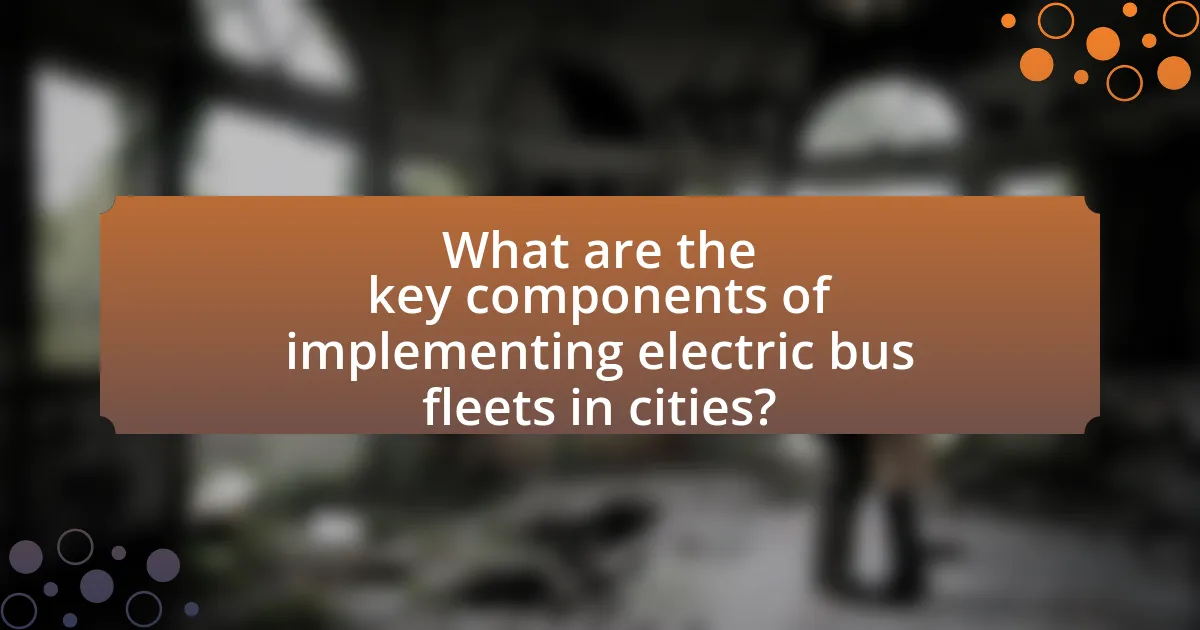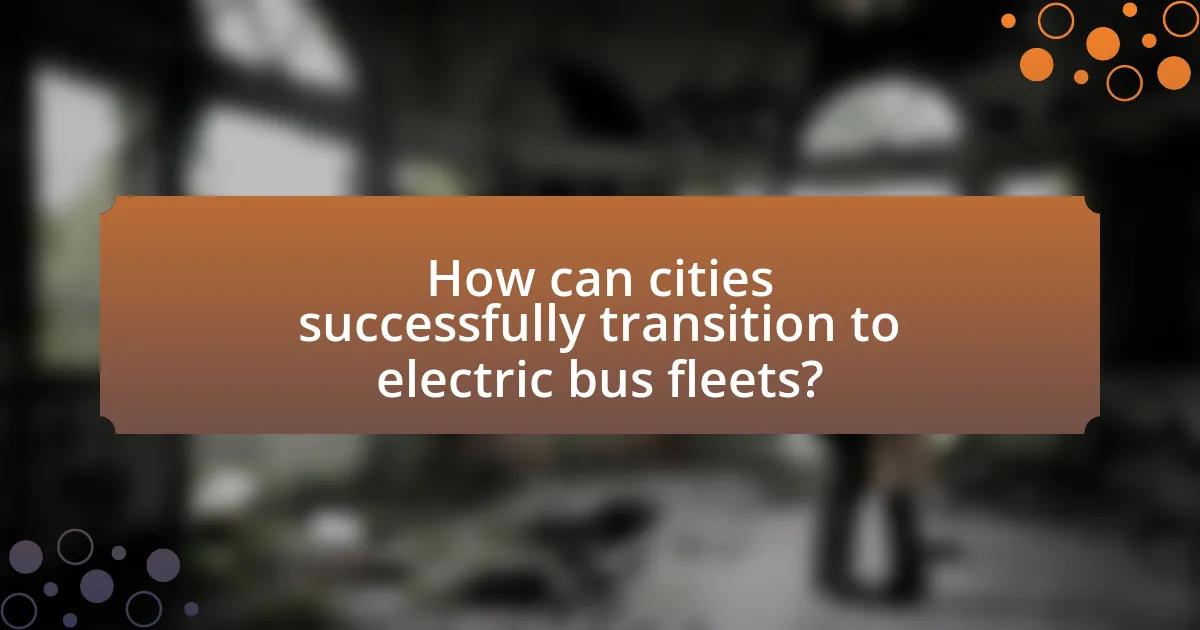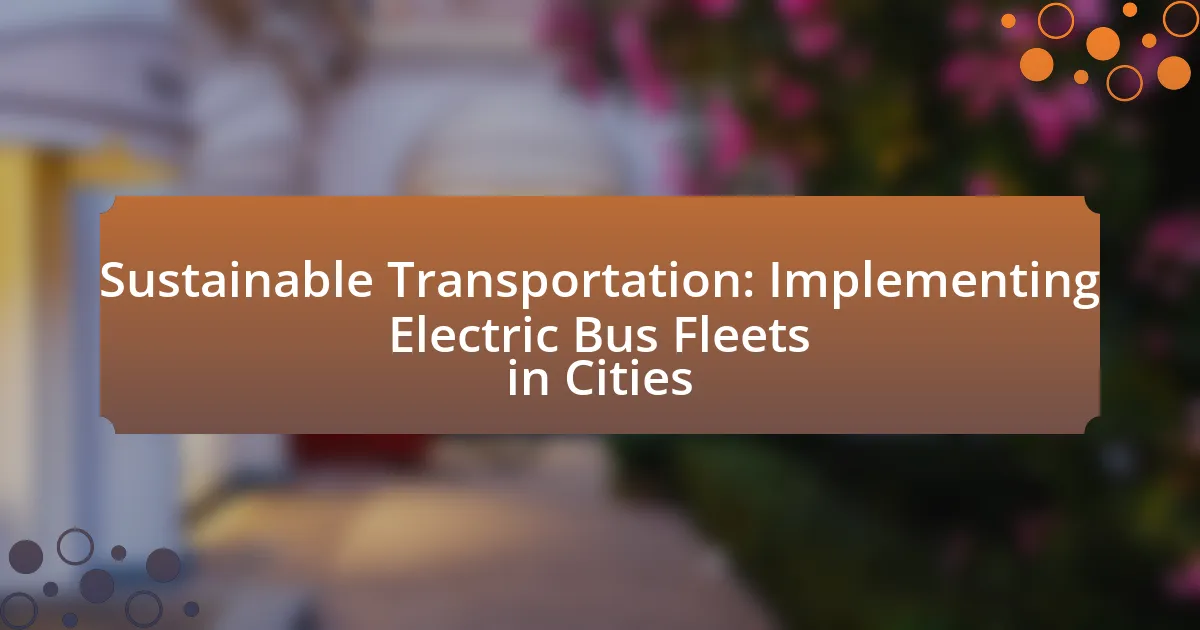Sustainable transportation, particularly through the implementation of electric bus fleets, plays a crucial role in reducing greenhouse gas emissions, improving air quality, and enhancing public health in urban areas. This article explores the environmental benefits of electric buses, their impact on urban congestion, and the challenges cities face in transitioning to these fleets, including high initial costs and infrastructure needs. It also discusses the financial implications, essential technologies, and supportive policies that facilitate the adoption of electric buses, along with best practices and lessons learned from successful case studies. By examining these components, the article provides a comprehensive overview of how cities can effectively implement electric bus fleets to promote sustainable urban mobility.

What is Sustainable Transportation and Why is it Important?
Sustainable transportation refers to modes of transport that have a low impact on the environment, primarily focusing on reducing greenhouse gas emissions and promoting energy efficiency. It is important because it addresses climate change, improves air quality, and enhances public health by minimizing pollution. For instance, electric bus fleets significantly reduce emissions compared to traditional diesel buses, contributing to cleaner urban environments and supporting sustainable urban development. According to the International Energy Agency, transitioning to electric buses can reduce CO2 emissions by up to 70% in urban areas, highlighting the critical role of sustainable transportation in combating climate change and fostering healthier communities.
How do electric bus fleets contribute to sustainable transportation?
Electric bus fleets contribute to sustainable transportation by significantly reducing greenhouse gas emissions and improving air quality in urban areas. These buses operate on electricity, which can be generated from renewable sources, thereby minimizing reliance on fossil fuels. According to a study by the American Public Transportation Association, electric buses can reduce emissions by up to 70% compared to traditional diesel buses. Additionally, electric buses produce less noise pollution, enhancing the quality of life in cities. The transition to electric bus fleets supports the broader goals of sustainable urban mobility by promoting cleaner, more efficient public transportation options.
What are the environmental benefits of electric bus fleets?
Electric bus fleets significantly reduce greenhouse gas emissions, contributing to improved air quality and lower urban pollution levels. Studies indicate that electric buses produce zero tailpipe emissions, which helps decrease particulate matter and nitrogen oxides in densely populated areas. For instance, a report from the American Public Transportation Association highlights that transitioning to electric buses can reduce carbon dioxide emissions by up to 70% compared to diesel buses. Additionally, electric buses are generally more energy-efficient, utilizing renewable energy sources that further minimize their environmental impact.
How do electric buses reduce urban congestion?
Electric buses reduce urban congestion by providing a more efficient and reliable public transportation option that encourages higher ridership. Their ability to operate on dedicated bus lanes and reduce the number of individual vehicles on the road leads to decreased traffic volume. Studies indicate that cities implementing electric bus fleets have seen a reduction in traffic congestion by up to 20%, as these buses can carry more passengers than private cars, effectively lowering the number of vehicles needed for the same number of commuters. Additionally, electric buses contribute to lower emissions, which can improve air quality and promote a shift towards public transit over personal vehicle use, further alleviating congestion.
What challenges do cities face in implementing electric bus fleets?
Cities face several challenges in implementing electric bus fleets, including high initial costs, limited charging infrastructure, and range anxiety. The high upfront investment for electric buses and necessary infrastructure can deter cities from transitioning, as electric buses typically cost 30% to 50% more than diesel buses. Additionally, the lack of adequate charging stations can hinder operational efficiency, making it difficult for buses to complete their routes without running out of power. Range anxiety, or the fear that electric buses will not have sufficient battery life to complete their routes, further complicates the transition. These factors collectively impede the widespread adoption of electric bus fleets in urban areas.
What are the financial implications of transitioning to electric buses?
Transitioning to electric buses has significant financial implications, primarily involving high initial capital costs but lower operational expenses over time. The upfront investment for electric buses can be approximately 70% higher than that of traditional diesel buses, with costs ranging from $700,000 to $900,000 per electric bus compared to $300,000 to $500,000 for diesel buses. However, electric buses offer reduced fuel costs, with electricity costing about one-third less than diesel fuel per mile. Additionally, maintenance costs for electric buses are generally lower due to fewer moving parts and less wear and tear, leading to savings of about 60% in maintenance expenses. Over a typical 12-year lifespan, these factors can result in total cost savings of up to $400,000 per bus when considering fuel and maintenance. Therefore, while the transition requires substantial initial investment, the long-term financial benefits can outweigh these costs, making electric buses a financially viable option for sustainable urban transportation.
How does infrastructure impact the deployment of electric bus fleets?
Infrastructure significantly impacts the deployment of electric bus fleets by determining the availability of charging stations, maintenance facilities, and operational routes. Adequate charging infrastructure is essential for ensuring that electric buses can operate efficiently without running out of power, as studies indicate that a well-distributed network of charging stations can reduce operational downtime and enhance route reliability. For instance, cities that have invested in extensive charging infrastructure, such as Los Angeles, have seen a smoother integration of electric buses into their public transit systems, leading to increased ridership and reduced emissions. Furthermore, the presence of dedicated maintenance facilities equipped for electric vehicles is crucial for minimizing service interruptions and ensuring the longevity of the fleet. Overall, the effectiveness of electric bus deployment is closely tied to the robustness and accessibility of the supporting infrastructure.

What are the key components of implementing electric bus fleets in cities?
The key components of implementing electric bus fleets in cities include infrastructure development, vehicle procurement, operational planning, and stakeholder engagement. Infrastructure development involves establishing charging stations and maintenance facilities to support electric buses, which is critical for ensuring their operational efficiency. Vehicle procurement requires selecting appropriate electric bus models that meet the city’s transportation needs and budget constraints. Operational planning encompasses route optimization and scheduling to maximize the effectiveness of the electric fleet while minimizing costs. Stakeholder engagement is essential for gaining support from the community, government agencies, and transit authorities, which can facilitate funding and policy support. These components are supported by successful case studies, such as Los Angeles’ electric bus program, which has demonstrated the feasibility and benefits of transitioning to electric fleets.
What technologies are essential for electric bus operations?
Essential technologies for electric bus operations include battery systems, electric drivetrains, charging infrastructure, and fleet management software. Battery systems, such as lithium-ion batteries, provide the necessary energy storage for electric buses, enabling longer ranges and efficient energy use. Electric drivetrains convert electrical energy into motion, offering higher efficiency compared to traditional combustion engines. Charging infrastructure, including fast chargers and depot charging systems, is crucial for maintaining bus availability and minimizing downtime. Fleet management software optimizes routes, monitors vehicle performance, and manages energy consumption, ensuring efficient operations. These technologies collectively enhance the performance, reliability, and sustainability of electric bus fleets in urban environments.
How do charging stations affect the efficiency of electric bus fleets?
Charging stations significantly enhance the efficiency of electric bus fleets by ensuring timely and adequate recharging, which directly impacts operational schedules and range. Efficient charging infrastructure allows buses to maintain consistent service intervals and reduces downtime, enabling fleets to operate at optimal capacity. For instance, a study by the National Renewable Energy Laboratory found that strategically placed fast-charging stations can increase the operational range of electric buses by up to 30%, thereby improving service reliability and reducing the need for additional vehicles. This integration of charging stations into urban transport systems is crucial for maximizing the effectiveness of electric bus fleets.
What role does battery technology play in electric bus performance?
Battery technology is crucial for electric bus performance as it directly influences range, charging time, weight, and overall efficiency. High-capacity batteries enable longer distances between charges, which is essential for urban transit routes. For instance, lithium-ion batteries, commonly used in electric buses, can provide energy densities of around 150-250 Wh/kg, allowing buses to travel up to 300 miles on a single charge. Additionally, advancements in fast-charging technology can reduce downtime, enabling buses to recharge in as little as 30 minutes, thus improving operational efficiency. The integration of battery management systems also optimizes energy use, enhancing the lifespan and reliability of the buses.
What policies support the implementation of electric bus fleets?
Policies that support the implementation of electric bus fleets include government incentives, funding programs, and regulatory frameworks. Government incentives, such as tax credits and grants, encourage transit agencies to invest in electric buses by reducing upfront costs. Funding programs, like the Federal Transit Administration’s Low or No Emission Vehicle Program, provide financial assistance specifically for the purchase of electric buses and related infrastructure. Regulatory frameworks, including emissions standards and clean air mandates, compel transit authorities to transition to cleaner technologies, thereby facilitating the adoption of electric bus fleets. These policies collectively create a supportive environment for the deployment of electric buses, promoting sustainable transportation initiatives in urban areas.
How do government incentives influence the adoption of electric buses?
Government incentives significantly accelerate the adoption of electric buses by reducing financial barriers and enhancing operational feasibility. These incentives, such as grants, tax credits, and subsidies, lower the initial purchase costs and operational expenses associated with electric buses, making them more attractive to transit agencies. For instance, the Federal Transit Administration’s Low or No Emission Vehicle Program provides funding that can cover up to 85% of the cost of electric bus purchases, which directly influences transit authorities’ decisions to transition from diesel to electric fleets. Additionally, incentives can include infrastructure support for charging stations, further facilitating the integration of electric buses into existing transit systems. Studies have shown that cities with robust government incentives experience a higher rate of electric bus deployment, demonstrating the critical role of financial support in promoting sustainable transportation solutions.
What regulations must cities consider when deploying electric bus fleets?
Cities must consider several regulations when deploying electric bus fleets, including federal, state, and local environmental standards, safety regulations, and funding requirements. Federal regulations, such as those set by the Environmental Protection Agency (EPA), mandate emissions standards that electric buses must meet, while the National Highway Traffic Safety Administration (NHTSA) outlines safety requirements for vehicle design and operation. Additionally, cities must comply with state regulations that may include incentives for electric vehicle adoption and infrastructure development. Local zoning laws and public transportation policies also play a crucial role in determining where charging stations can be installed and how bus routes are structured. Compliance with these regulations ensures that electric bus fleets operate efficiently and sustainably within the urban environment.

How can cities successfully transition to electric bus fleets?
Cities can successfully transition to electric bus fleets by implementing a comprehensive strategy that includes infrastructure development, funding allocation, and stakeholder engagement. Infrastructure development involves installing sufficient charging stations and ensuring that the electrical grid can support increased demand; for instance, cities like Los Angeles have invested in over 100 charging stations to facilitate this transition. Funding allocation is crucial, as cities must secure financial resources through federal grants, public-private partnerships, or green bonds; the Federal Transit Administration has provided billions in grants specifically for electric bus initiatives. Stakeholder engagement, including collaboration with transit authorities, local governments, and community organizations, ensures that the transition meets the needs of all parties involved, as seen in Seattle’s approach, which involved extensive community input. These combined efforts create a robust framework for cities to effectively transition to electric bus fleets.
What best practices should cities follow for effective implementation?
Cities should prioritize stakeholder engagement and comprehensive planning for effective implementation of electric bus fleets. Engaging stakeholders, including community members, transit authorities, and local businesses, ensures that the needs and concerns of all parties are addressed, fostering public support and collaboration. Comprehensive planning involves assessing current transportation infrastructure, identifying optimal routes for electric buses, and integrating charging stations strategically throughout the city.
Evidence from cities like Los Angeles, which has successfully implemented electric bus fleets, shows that thorough planning and community involvement lead to increased ridership and reduced operational costs. Additionally, cities should invest in training for staff to maintain and operate electric buses effectively, as seen in Seattle’s approach, which has resulted in improved service reliability and efficiency.
How can public engagement enhance the adoption of electric bus fleets?
Public engagement can enhance the adoption of electric bus fleets by fostering community support and increasing awareness of the benefits of electric transportation. When local communities are actively involved in the planning and implementation processes, they are more likely to understand the environmental and economic advantages of electric buses, such as reduced emissions and lower operating costs. Research indicates that cities with strong public engagement initiatives, like informational campaigns and community forums, see higher acceptance rates for new transportation technologies. For instance, a study by the Transportation Research Board found that public participation in transit planning significantly correlates with increased ridership and satisfaction, demonstrating that informed and engaged citizens are more likely to embrace electric bus fleets.
What strategies can be employed to ensure a smooth transition?
To ensure a smooth transition to electric bus fleets in cities, comprehensive planning and stakeholder engagement are essential. This involves conducting thorough assessments of existing infrastructure, identifying necessary upgrades, and ensuring that charging stations are strategically located to support the new fleet. Engaging with local communities, transit authorities, and government agencies fosters collaboration and addresses concerns, facilitating acceptance and support for the transition. Additionally, providing training for operators and maintenance staff on electric bus technology ensures operational efficiency and safety. Research indicates that cities that prioritize these strategies, such as Los Angeles and Seattle, have successfully integrated electric buses, demonstrating the effectiveness of structured planning and community involvement in achieving a seamless transition.
What lessons can be learned from cities that have successfully implemented electric bus fleets?
Cities that have successfully implemented electric bus fleets demonstrate several key lessons. First, comprehensive planning and stakeholder engagement are crucial; cities like Shenzhen, which transitioned its entire fleet to electric buses, involved extensive collaboration with manufacturers, local governments, and the community to ensure smooth implementation. Second, investing in charging infrastructure is essential; cities such as Los Angeles have shown that strategically placed charging stations can enhance operational efficiency and reduce downtime. Third, data-driven decision-making is vital; cities like London utilize real-time data analytics to optimize routes and improve service reliability, leading to increased ridership. Lastly, securing funding and incentives from government programs can significantly offset initial costs, as seen in various U.S. cities that have leveraged federal grants to support their electric bus initiatives. These lessons highlight the importance of strategic planning, infrastructure investment, data utilization, and financial support in the successful deployment of electric bus fleets.
What case studies highlight successful electric bus fleet implementations?
Successful electric bus fleet implementations are highlighted by case studies from cities like Los Angeles, Shenzhen, and London. Los Angeles has integrated over 200 electric buses into its fleet, resulting in a significant reduction in greenhouse gas emissions and operational costs. Shenzhen, China, has transitioned its entire fleet of over 16,000 buses to electric, showcasing a commitment to sustainable public transport and achieving a 100% electric bus fleet. London has also made strides with its electric double-decker buses, contributing to cleaner air and reduced noise pollution in the city. These case studies demonstrate the effectiveness of electric bus fleets in enhancing urban sustainability and reducing environmental impact.
How have these cities measured the success of their electric bus initiatives?
Cities have measured the success of their electric bus initiatives primarily through metrics such as ridership levels, operational cost savings, and reductions in greenhouse gas emissions. For instance, cities like Los Angeles reported a 20% increase in ridership on electric bus routes, indicating public acceptance and usage. Additionally, operational costs have decreased by approximately 30% due to lower fuel and maintenance expenses associated with electric buses compared to diesel counterparts. Furthermore, emissions data showed a significant reduction, with some cities achieving up to a 50% decrease in CO2 emissions from public transport, validating the environmental benefits of transitioning to electric bus fleets.
What are the future trends in electric bus fleet implementation?
Future trends in electric bus fleet implementation include increased adoption of autonomous driving technology, enhanced battery technology for longer ranges, and integration with smart city infrastructure. Autonomous electric buses are expected to improve operational efficiency and reduce labor costs, as demonstrated by pilot programs in cities like San Francisco. Advancements in battery technology, such as solid-state batteries, are projected to extend the range of electric buses beyond 300 miles, addressing range anxiety and making them more viable for longer routes. Additionally, the integration of electric bus fleets with smart city systems, including real-time data analytics for route optimization and energy management, is anticipated to enhance overall public transportation efficiency. These trends are supported by investments from both public and private sectors, with global electric bus sales projected to reach over 1 million units by 2025, according to the International Energy Agency.
How might advancements in technology shape the future of electric buses?
Advancements in technology will significantly enhance the future of electric buses by improving battery efficiency, enabling faster charging, and integrating smart systems for better operational management. For instance, the development of solid-state batteries promises to increase energy density and reduce charging times, potentially allowing electric buses to travel longer distances on a single charge. Additionally, innovations in charging infrastructure, such as wireless charging and ultra-fast charging stations, will facilitate more convenient and efficient operations. Furthermore, the incorporation of artificial intelligence and IoT technologies can optimize route planning and maintenance schedules, leading to reduced operational costs and improved service reliability. These technological advancements collectively contribute to the viability and attractiveness of electric buses as a sustainable transportation solution in urban environments.
What role will public policy play in the evolution of electric bus fleets?
Public policy will play a crucial role in the evolution of electric bus fleets by establishing regulatory frameworks, providing funding, and incentivizing adoption. Governments can implement policies that mandate the transition to electric buses, such as emissions standards and procurement requirements for public transit agencies. For instance, California’s Innovative Clean Transit regulation requires all public transit agencies to transition to zero-emission buses by 2040, demonstrating how policy can drive fleet electrification. Additionally, public funding programs, like the Federal Transit Administration’s Low or No Emission Vehicle Program, offer financial support for the purchase of electric buses, further accelerating their deployment. These policies not only facilitate the growth of electric bus fleets but also contribute to broader environmental goals, such as reducing greenhouse gas emissions and improving air quality in urban areas.
What practical steps can cities take to begin implementing electric bus fleets?
Cities can begin implementing electric bus fleets by conducting a comprehensive feasibility study to assess infrastructure needs, operational costs, and potential routes. This study should include evaluating existing bus depots for charging station installation, determining the required number of electric buses based on ridership data, and analyzing the local grid’s capacity to support increased electricity demand.
Additionally, cities should secure funding through federal grants, state programs, or public-private partnerships to cover the initial investment costs. For instance, the Federal Transit Administration offers grants specifically for electric bus projects, which can significantly offset expenses.
Cities must also engage with stakeholders, including transit authorities, local governments, and community organizations, to ensure public support and address any concerns. Implementing pilot programs can provide valuable insights into operational challenges and help refine the transition strategy.
Finally, cities should establish a timeline for phased implementation, starting with a small fleet of electric buses and gradually expanding as infrastructure and funding allow. This approach allows for adjustments based on real-world performance and community feedback.
